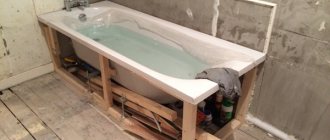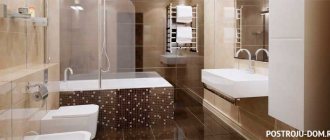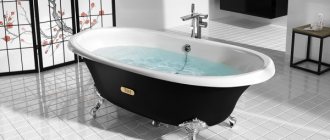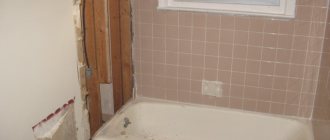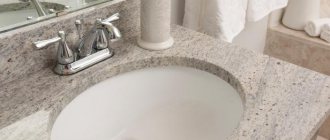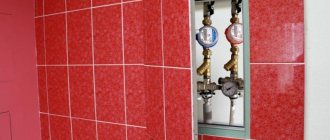The screen under the bathtub is a relatively simple but practical design.
Such a decorative product consists of several basic elements, most often represented by a frame, as well as panels and doors, sometimes shelves and drawers.
This design is quite easy to make yourself.
MDF screens
Screen for bathtub sliding MDF Still from Alavann
They are made from wood board with a film coating.
Why choose MDF panels:
- Easy to maintain - all dirt is easily washed off.
- Variety of designs: you can choose not only a front version, but also an end version, which is indispensable in situations where the bathtub bowl is open on both sides and is not installed tightly between the walls. Both sides are firmly attached to the frame and perform their functions perfectly.
- Affordable price.
Their disadvantages include only standard sizes, which in some cases may not coincide with the dimensions of your bathroom.
Simple and cheap: bath curtains. Perhaps the most budget-friendly, but not very convenient solution, used when it is impossible to find a ready-made option for a bathtub of a non-standard shape. Curtains are not very convenient to care for, and perhaps in this case it makes sense to make them to order.
What are bath screens made of?
- Plastic: plastic screens are lightweight, not susceptible to the negative effects of moisture, do not change color, and do not scratch. They can be made in any color, have a pattern, or even be decorated with a picture using photo printing. These types of panels are the most affordable. Their main disadvantage: they are not resistant to mechanical damage (shocks).
- MDF is a rare type of screen, which is made from wood board protected from moisture. The main advantage of a model made from this material is the ability to order a screen with doors identical to the furniture available in the bathroom. The main disadvantages are the need to make the product to order and not the cheapest cost.
- Acrylic: acrylic panels are usually produced by manufacturers for specific bathtub models, most often for corner bathtubs - asymmetrical or triangular. The material is good for its durability and aesthetic appearance. In particular, a white acrylic screen will look more attractive than a plastic one. The main advantage is the creation of a holistic (visually monolithic) composition with the bathroom.
- Glass or mirror: these materials are also used to create doors for sliding or hinged screens, but such products are made only to order, for designer interiors. Their cost is quite high. To implement the idea, only impact-resistant tempered glass is used, which is difficult to damage and which, when broken, does not break into dangerous fragments that are easy to cut on.
Glass and mirror screens
This is the best choice of screen for a bathtub designed in an ultra-modern style. Most often, sliding models are made of glass. Organic glass is a moisture-resistant material that does not allow the growth of mold and bacteria. Another advantage is the strength of this material.
Separately, we should mention a practical and original option - panels made of organic glass with mirror coating, which perfectly complement almost any interior.
By choosing such a screen for the bath and correctly placing the other mirrors, you will get the effect of an expanded space and a room filled with light. True, the mirror surface is somewhat more difficult to care for and use in everyday use than the usual plastic doors.
Most popular materials
For the manufacture of screens, durable materials that are not subject to corrosion are used. This guarantees the strength of the frame and the absence of deformation for a long time.
The panel must be made of materials that are resistant to moisture and high temperatures. In the event of a decorative panel breaking, the fragments and fragments must be such as not to injure a person.
The front finish can be anything - ceramic tiles, mirror, glass, etc.
Most often, buyers choose screens from the following materials:
- brick;
- plastic;
- metal;
- drywall;
- tongue-and-groove slabs;
- acrylic;
- MDF panels;
- plexiglass.
Glass always looks great in a bathroom, which is why it is often chosen for screens. However, it should always be taken into account that the material must be safe and resistant to mechanical damage
Option #1: Solid brickwork
Sometimes the space under the bathroom is simply covered with a small brick wall, which is then finished with the same tiles as the walls. The masonry is made in 1/2 or 1/4 bricks.
To do this, first mark the location of the wall so that after cladding it is flush with the side of the bathtub. If necessary, the bricks of the upper part of the wall are adjusted to size.
A brick wall as a screen can last for several decades. She is not afraid of any external influences or mechanical damage.
On the other hand, it also has obvious disadvantages. Access to communications is closed; no manipulations with the space under the bathroom are possible.
This screen is superior in strength and reliability to any other. Usually, when installing a screen-wall, a small inspection window is left so that you do not have to disassemble the entire wall to inspect and repair communications. This opening can be open or closed with a door
Option #2: Drywall screen
Drywall is a very convenient material for creating a continuous screen under a bathtub. Its installation begins with the formation of a durable frame.
Most often, either a metal profile or a wooden beam treated with an antiseptic composition is chosen for the frame. The frame is marked taking into account the facing finishing material.
The seams between the profile and the bathroom floor are treated with sealant to prevent moisture from entering the space under the bathtub.
The screen can be flat, or it can have a special niche for the feet. In the second case, when installing a profile, it is not mounted vertically in a straight line, but with a recess in the shape of the letter “P”.
The depth of such a niche is usually 10-15 cm. The finished frame is covered with sheets of moisture-resistant plasterboard, which is then primed and finished with facing material.
Tile, plaster, and wallpaper are suitable as cladding. When installing drywall, take into account that it can swell when in contact with water.
The sequence of work is described in detail in the video tutorial:
Option #3: MDF and OSB boards
In addition to drywall, you can use MDF and OSB boards. In this case, they are primed even before the framing of the frame begins. You will also need to additionally make ventilation slots 5-10 cm long and 2-3 cm wide.
They are cut in the direction opposite to the technological opening. Subsequently, the cracks can be covered with a plastic grill. Otherwise, installing a screen made of MDF and OSB is no different from installing a plasterboard structure.
You can purchase a ready-made MDF screen. Such panels are either solid or sliding. They look nice, fit well into the interior, and are often very convenient to use, but even laminated boards are sensitive to moisture.
They rarely retain their original appearance for more than three years. The cheaper the material, the higher the likelihood that the film will peel off due to high humidity, and the surface of the skin itself will be deformed.
Under the bathroom screen, you can install a frame made of wooden beams 40x40 cm. When marking, you need to take into account changes in the thickness of the skin under the influence of moisture and the thickness of the facing material
Option #4: Plastic and plastic lining
Manufacturers of plastic screens claim that their products can last 10-30 years. In principle, this is possible provided that the panels are handled carefully.
The advantages of ready-made plastic models are a variety of colors and textures, ease of installation, operation, and maintenance. There are designs with shelves, sliding, fully opening and even removable.
The main advantage of plastic lining is its pleasant appearance. Such a screen does not require additional covering with facing material.
Attach it to a starting profile made of metal or wooden beams. If you choose a budget option - cheap lining, then you should pay special attention to the fastening of the profile.
The profile for the lining is firmly fixed around the entire perimeter of the screen and in the middle. Such precautions are necessary due to the low resistance of the lining to mechanical damage.
The profile is additionally secured to the floor using sealant. The plastic is cut with a construction knife and the edges are brought behind the profile, gradually gaining the entire decorative panel.
At the drainage point of the bathtub, a technological opening is made for servicing the plumbing. To do this, install a plastic frame with a hinged door.
Such a door can be purchased at a hardware store. The panel can be solid or consist of separate strips placed at a short distance from each other.
Screens made from plastic lining are not as durable as plasterboard or brick, but they are very beautiful and quite functional. A wide range of colors and textures allows you to create an aesthetic design that will decorate your bathroom
Option #5: Organic glass and mirror
Bath screens made of organic glass and mirrors look very original. This design can be purchased at a specialized store.
Usually these are sliding models that provide access to all communications. Plexiglas is practically eternal. It is not afraid of high humidity, does not swell and does not promote the proliferation of microorganisms.
In terms of strength, organic glass is not inferior to plastic, but it may not withstand serious impacts and scratches.
Plexiglass can be matte, transparent, with a pattern, any color and texture. Screen manufacturers produce a wide variety of models with different types of shutter openings.
The choice is great, and every buyer can find the ideal option for their own bath. Glass models look great in bathrooms decorated in an ultra-modern style. They are installed on a metal frame.
Mirror models are popular, but installing a real mirror at the bottom of the bathtub is quite risky, so manufacturers have proposed a more practical option - mirror-coated plexiglass panels.
They are stronger than a regular mirror, easy to clean and look just as luxurious. Plexiglass is quite difficult to break, but if it does break, the fragments will be small and harmless.
The mirror screen is universal; it always looks good in any interior.
Mirror designs are used not only as decoration and for utilitarian purposes. They perfectly model space. By installing such a screen and correctly placing mirrors in the bathroom, you can visually expand the bathroom. It will appear larger and lighter
Option #6: Aluminum screens
If you are looking for the best option in terms of price-quality ratio, pay attention to aluminum models. They are somewhat more expensive than their budget plastic counterparts, but are stronger and more durable.
Aluminum does not rust and retains its original appearance for a long time. The market offers many models, but the most popular among them are sliding structures.
The end wall of an aluminum screen can be made not only of metal, but also of organic glass or plastic.
Durable metal models are much more practical than plastic or plasterboard counterparts. If aluminum doors do not fit into the interior, you can find a combined model - with plastic or glass
Option #7: Acrylic models
These are specific screens that are only suitable for acrylic bathtubs and are usually sold complete with them. The main material for the manufacture of such screens is plastic with an upper front covering of acrylic.
Sizes and shapes are designed for a specific bathtub, so finding a universal acrylic screen suitable for different models can be very difficult.
On the other hand, when purchasing an acrylic bathtub with a screen, the problem of masking communications is solved automatically.
The panels of the structure do not differ in color from the bathtub, fit tightly to the sides, and the frame and fastening elements are supplied complete.
Acrylic screens for specific bath models can be either solid or sliding. When choosing a bathtub, it makes sense to pay attention to the screen, because... the ease of use and appearance of the entire room largely depend on this
Aluminum screens
Aluminum screen for bathtub
Perhaps, this is one of the best options for choosing a screen for a bath based on the price-quality ratio. Aluminum models rarely break and last a long time.
Sliding structures are also the most popular here. A mixed version is often used, when one wall is plastic or, for example, glass with a mirror coating.
No. 4. Removable non-sliding screens: pros and cons
Such screens are often found as an element of modern acrylic bathtubs. Its main advantage is that it can have almost any shape, so it can be used to cover the space under the bathroom of any configuration. Such screens have a good appearance, and with them the bath is perceived as something unified.
The purpose of the removable screen is to hide all communications away from our eyes, but, at the same time, to leave convenient and easy access to them, which is a mandatory security requirement. Installation of such screens is not as simple as, for example, sliding ones, and they are not so easy to remove, so the space under the bathroom cannot be used for storage. Although, in principle, it is possible to put items there that may be needed once every two years.
Monolithic cladding
Monolithic cladding is more of a way to fence off space. It opens up new design possibilities, but at the same time loses greatly in functionality. If it becomes necessary to gain access to the drain or pipes, the lining will have to be dismantled. And of course, any use of the space under the bathroom becomes impossible.
Sometimes small shelves for storage are provided inside the facing structure.
However, there is a way to gain access to communications without harming the bathroom decor - leave a special, uncovered space to troubleshoot possible problems. You can install a ready-made inspection hatch in it or attach one of the tiles yourself with magnets.
To do this, four small magnets are glued to the corners of the tile and four more are attached to the sides of the hole. Then access to the water pipes can be obtained with a slight movement of the hand.
Preferred Materials
Several types of materials are used in the production of screens, each with its own advantages and disadvantages. It is important to take them into account in order to choose the best quality model that will last for several years and be easy to maintain.
Aluminum
A good and lightweight metal that has a low price and attractive appearance. The product is suitable for placement in a room where a minimalist style is used. However, it can also be used in other solutions, since the screens are available in a wide range of colors. Another advantage is durability. Often the service life exceeds 5 years. Despite the positive aspects, this decision also has a negative side - a person must monitor the external condition and constantly provide proper care. If this does not happen, the durability will be reduced significantly, which will cause inconvenience.
High strength plates
Like the previous material, the records must be constantly monitored so that they do not become covered with plaque and lose their technical properties. But this solution also has positive aspects - practicality, ease of self-installation, high strength parameters, hundreds of design solutions and durability. Therefore, products made from this material are widely popular among many buyers.
MDF panels
A budget solution that is distinguished by high stylistic choice, has a special water-repellent coating and easy maintenance. If the user is looking for a cheap design that will suit any interior, then this is a suitable solution that will transform the room. There are negative points, and there are several of them:
- Short service life;
- Risk of deformation during operation or installation;
- It is not recommended to use in places with poor ventilation, otherwise the protective layer will quickly disappear.
Ceramic screens
The material itself is distinguished by its beautiful external design, reasonable price and ease of installation. The disadvantages include the plasterboard base, which quickly deteriorates and is not able to withstand small mechanical shocks, which is why it quickly deforms. Caring for such products is simple. A person will need a minimum of cleaning products, since the main element does not deteriorate from household chemicals, but it is still not worth using abrasive substances.
Tree
A natural material that is distinguished by its design and the ability to be used in various structures, including monolithic ones. Resistance to moisture is average; at the production stage the product is covered with a protective layer, but even this does not save the wood from liquid penetration. To preserve the original appearance, users are advised to carry out the processing themselves, but they cannot save on substances. Also, the products are not very durable and may become deformed during installation. Therefore, it is better to entrust the assembly stage to a professional.
Plexiglass
Finding a suitable color or design from this material will not be difficult, since manufacturers produce screens in any color range. The appearance will decorate every interior, and the strength and durability indicators are at a high level. There are also disadvantages to this design - the screen is easily scratched, so it must be carefully looked after.
Acrylic
Screens made from this element show high resistance to water, have a beautiful appearance, do not require careful maintenance and are used in various designs. However, all these advantages apply only to expensive models, since cheap products emit toxic fumes, which subsequently become airborne. Budget options have low resistance to deformation.
Which screen design should you choose?
The most popular and easy to use are sliding models. The door plates move inside a rigid frame. On one side there is access to the pipes under the bathtub, and on the other there is storage space.
Unfortunately, despite this, this option cannot be called optimal. The structure is quite difficult to firmly fix; the doors also have to be replaced after a short time.
But if you need an option that is easy to install and use, it is better to choose a sliding screen for the bathroom.
Screen for bathtub sliding MDF Still from Alavann
The hinged screen is a replica of the sliding design theme. The doors in them do not move to the side, but swing outward. Before choosing a similar screen for the bathroom, you should make sure that there is enough space in the bathroom to open and close the doors freely.
Hinged screen for bathtub
There are sliding models even for corner baths. With their help, the bathtub becomes a shower stall, very beautifully decorated with a wide variety of effects.
An original and functional solution for spacious rooms is a design with a withdrawable unit. Drawers of different sizes and volumes can accommodate a variety of storage containers. A similar screen is shown in the photo.
Roll-out screen for bathtub
Folding structures, which appeared relatively recently, are becoming increasingly popular. The solid door is attached to the frame using a gas lift or other mechanisms, opens easily and can be locked in the ajar position.
Inside the door there are shelves or special baskets in which it is convenient to store household items or household chemicals.
Folding screen for bathtub MDF Soft from Alavann
Main features of screens
Regardless of the size, configuration and material of manufacture, the design of bathroom screens is a frame in the form of a frame or two guides. As a rule, they are made of aluminum, steel or dense plastic . Structural panels, which can be attached to the wall, have a holistic structure or consist of several parts. Most often, they move along guides, but they can also open like doors, providing access to plumbing communications.
The key features of bath screens are:
- for acrylic bathtubs, screens range in size from 1.5 to 1.7 m in length and about 0.500 m in height;
- adjust the designs depending on the type of bathtub, using the legs that come with the screen;
- There are universal models , where curtain panels in an aluminum frame can be adjusted to the desired size; such screens can be installed even in places where PVC-based pipes pass;
- stationary type structures in a frame are not adjustable and have a static size;
- products without a frame can be used for the open end area and inserted into the main frame;
- non-standard designs such as end or semicircular ones are practically not suitable for cast iron bathtubs.
How to choose a bath screen size?
First of all, carefully measure the bathtub from all sides. When choosing, it is worth considering that it is easiest to install the model yourself on legs with adjustable height.
Despite the wide choice, the vast majority of models have a standard height - 50 or 60 cm and a length from 150 to 180 cm. Models with dimensions of 100-120 cm are less common.
The height of MDF screens is most often 56 cm. If it does not fit in dimensions, you can simply saw down the panels and varnish the sections.
This design provides additional storage space. Often, shelves with sides are even built under the bathtub, on which, for example, detergents can be stored.
The length of plastic screens for acrylic bathtubs usually varies between 150-170 cm, and the height ranges from 50 to 56 cm and is adjustable using retractable legs. It is convenient when there is a small space left under the frame, making it possible to get close to the bathtub.
The easiest way is to choose the size of removable one-piece structures - they are usually available in various sizes.
But it is not enough just to choose the size of the screen for the bath. It is worth considering the location of the pipes - you may have to cut the panels yourself or swap the stationary and movable panels.
In addition, it makes sense to carefully check the quality of the fittings - the service life and ease of use of the product also depend on it. It is best if the handles are made of stainless material – galvanized steel.
Choosing screen handles made of stainless material
If you have chosen a design with doors, check that they are securely fastened, look at what the hinges are made of. In sliding models, the quality of the roller mechanism is of particular importance - the doors should move without any effort.
You should also not count on the long service life of plastic fittings.
Sliding panel design
Sliding panels can have an aluminum or plastic frame; more expensive models can be equipped with roller mechanisms. Each of these designs has its own advantages and disadvantages that need to be taken into account.
Thus, plastic sliding screens are the most budget-friendly , but at the same time they are completely neutral to moisture and quite durable. Plastic frames can be made in a variety of colors that won't peel or wash off. But the disadvantage of this type of frame is its fragility. An accidental blow can easily break it. Aluminum structures are stronger than plastic frames, but are not as resistant to constant humidity.
A variety of colors is also inherent in this type, but over time the paint may begin to peel off, which will not only affect the attractive appearance, but also protect the aluminum from moisture. That is, the main advantage of aluminum, unlike plastic, is strength.
The sliding design for a bathtub on casters is similar to that used in sliding wardrobes. Rollers are attached to the screen and move along guides. Due to them, the panels slide smoothly. Regarding appearance, these screens look aesthetically pleasing. Among the disadvantages: accordingly, a more complex design is more expensive than systems made from other materials , as well as a small number of ready-made structures.
Plastic
Sliding panels for bathtubs made of plastic are the most popular due to the practicality of the material and the cost of the design itself. Plastic has gained great popularity due to its qualities:
- resistant to rotting;
- resistant to temperature changes;
- resistant to mold and mildew.
The most important property of the material regarding the bathroom is that it is completely waterproof. There is always high humidity in the bathroom, so some materials are not profitable to use in such a room. Over time, they can rot, mold and swell. This will never happen with plastic.
Plastic panels are the cheapest, but still have good strength so that they can be installed in the bathroom. Moreover, consumers are captivated by the variety of designs. There are plain options or painted with various drawings and paintings. These patterns are applied using photo printing . If you wish, you can paste a picture according to your order. Plastic can be easily washed. It is very easy to remove any stains and stains from it, and for the lazy it is beneficial because it can hide small stains. Therefore, it is not necessary to wash the plastic panels under the bathtub every day. In addition, you can easily make a sliding plastic screen with your own hands. This is made possible by the availability of materials and simplicity of design.
Screen for acrylic bathtub
In plumbing stores you can see screens for acrylic bathtubs. These sliding systems most often come as an addition to an acrylic bathtub . Manufacturers create them in a unique design with an original shape. But the acrylic screen can be purchased separately. However, it is only suitable for acrylic bathtubs.
These panels are made of plastic and then coated with acrylic. They are only suitable for acrylic bathtubs, as they have a special mount.
Bath screen made of MDF
MDF is often used to make furniture . And although some believe that this material does not combine well with high humidity, at the same time this opinion is incorrect. Today, moisture-resistant MDF panels are manufactured, which are impregnated with special resins, giving the material water-repellent properties. That’s why MDF screens are quite popular today. These sliding systems are durable, convenient and practical. Like plastic panels, they have a large number of colors and are also decorated with various patterns and designs. For additional protection from moisture, the surface of these panels is laminated with paper-melamine or plastic films.
Since MDF board is much heavier than a plastic screen, metal guides are used in the panels for the bathtub, which are able to ensure the movement of the panels and reliable fastening. The sliding system itself also undergoes certain changes; it often consists of three MDF panels, while the central one is stationary, to further ensure strength, the panels on the sides move as in a wardrobe.
No. 5. Stationary screen - an immortal classic
Such screens are usually made individually. They are considered the most aesthetic, as they allow the bath to best fit into the interior of the space , facing with the same tiles or mosaics as the walls of the room. However, such screens also provide you with access to communications to detect possible problems: a small door can swing open, slide apart, recline or be removed like a hatch cover, but you won’t be able to store anything behind this door.
This type of screen can be called the most durable, and in terms of cleaning it is as simple as possible. But, at the same time, some disadvantages of such screens . So, a small window may not be enough for full access to communications, and then you will have to disassemble the screen. The same will have to be done if the bathtub is replaced. The floor under the bathroom behind the screen is unlikely to be thoroughly cleaned, since these places are difficult to reach. In terms of installation, such screens are also not simple: first, the frame is mounted and sheathed with plasterboard, or brickwork is created , and then the tiles are laid. When creating such a screen at home, do not forget to leave a small gap at the very bottom, near the floor, so that it is convenient to get close to the bathtub.
Tips for choosing a screen
Before purchasing a bathtub protection panel, you need to pay attention to the following points:
- Before purchasing a panel, it is recommended to take measurements of the bathroom and bowl;
- the choice of product design depends on two factors: the financial capabilities of the buyer and the dimensions of the bathroom. For example, it is not recommended to purchase folding screen models for bathrooms, the dimensions of which are standard. For small spaces, solid models are best;
- a model with doors allows you not only to protect communications, but also to organize a small storage area under the bathroom for household chemicals and other items;
It is important to take into account when choosing a screen so that it meets all requirements and is as functional as possible in a particular bathroom.
- It is recommended to pay attention to the material from which the panel fittings are made. It is very important that the material has good resistance to corrosion;
- the panel must be freely adjustable, so you need to check the legs before purchasing the product;
- Aluminum is considered the optimal material for the panel frame;
- MDF bathroom screens are suitable for rooms equipped with a good ventilation system. Otherwise, due to stagnation of moisture, this material can quickly become unusable.
The design of the panel is selected depending on the individual preferences of the apartment owners. Assembling a bath screen with your own hands will save you a lot of money.
What to look for when choosing a screen design
When choosing a box design, you should pay attention to many factors.
- Materials.
- Design.
- Your financial capabilities.
- Dimensions.
- General design of the room.
You can buy a screen for a sliding bathtub in any construction hypermarket or specialized store.
We will talk about the first two selection criteria a little later, since such important topics need to be allocated separate time. The third point will be individual for each family and it is extremely difficult to predict, but it is immediately clear that plastic products will be the cheapest and most accessible material common on the building materials market. Now we will look at the last two points.
It is not difficult to choose and order the product you like via the Internet.
Design. Everything is simple here, the main thing is to select panels that will fit perfectly into the interior of your bathroom.
The panel fits organically into the interior of the bathroom.
Advice! If you are not completely confident in your design literacy, then spare no expense and seek help from a specialist. Or try to be inspired by collections of photos of successful designs.
Dimensions. Everything here is a little more complicated, but if you try to understand this topic, everything will become clear and simple. At the moment, manufacturers produce panels with a minimum length of 105 centimeters and a maximum length of 190 centimeters.
The cladding of such a product is usually made with the same materials as the rest of the room.
The width can be from 50 to 56 centimeters. But the thickness of all is standard -3 millimeters.


